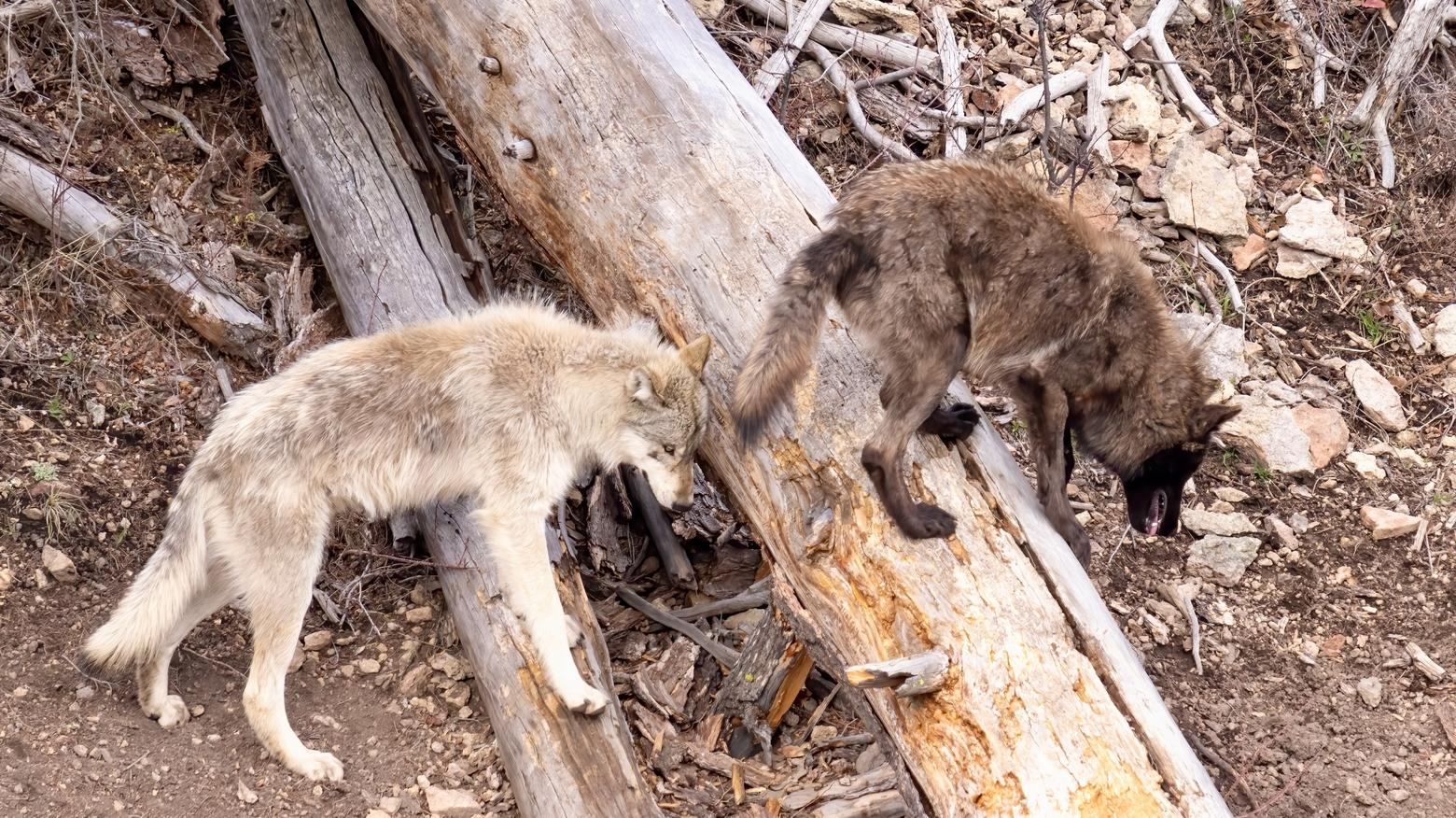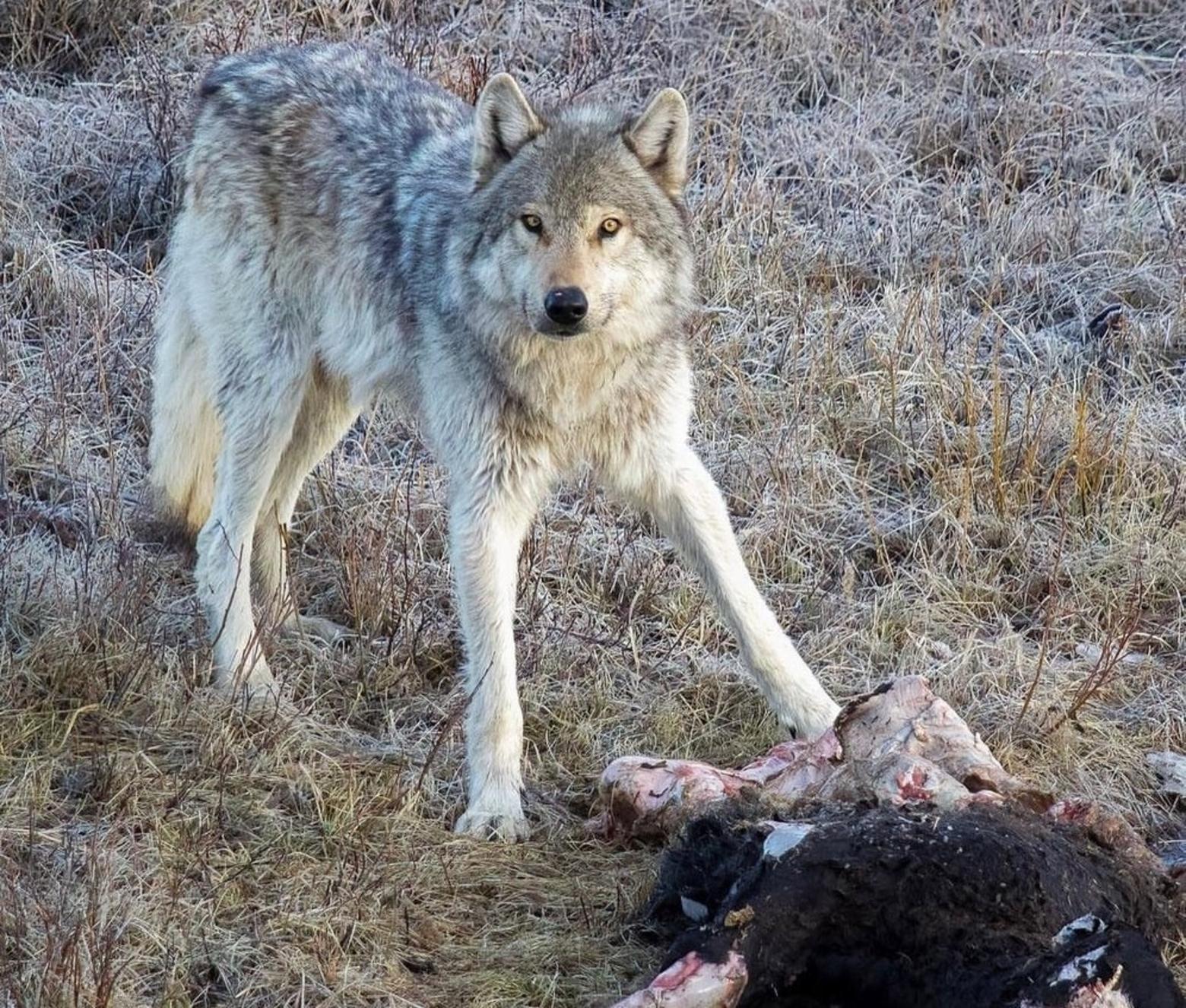Back to StoriesMontana Updates Wolf Management Playbook as Hunting Bills Advance
April 3, 2025
Montana Updates Wolf Management Playbook as Hunting Bills AdvanceWildlife managers release first wolf management plan in 22 years, set minimum baseline population to 450
by Sophie Tsairis
Management of Montana's gray wolves continues to spark fierce debate, their future hanging in the balance between science-based conservation and mounting political pressures. Last week, Montana Fish, Wildlife and Parks unveiled its finalized 2025 Gray Wolf Conservation and Management Plan capping two decades of state oversight even as lawmakers advance multiple bills that would significantly expand wolf hunting across the state.
The updated plan replaces the original 2003 framework that has guided Montana wolf management since the species was federally delisted in 2011. Gray wolves in the contiguous 48 states, with the exception of the Northern Rocky Mountain population, are currently protected under the Endangered Species Act. While FWP officials frame the revision as a modernization effort incorporating scientific advances, wildlife advocates and wolf biologists have raised significant concerns about the methodology behind population estimates and management goals.
“The former wolf plan served us well,” FWP Director Christy Clark said in a March 26 press release. “But it was time to make sure our management plan contained the evolutions we’ve made in wolf research, monitoring, conflict management, and the changes to the legal framework we operate under today.”
Molly Parks, carnivore coordinator for FWP, told Mountain Journal the new plan builds off the 2003 strategy, using it as a foundation and pulling in new updates, research and monitoring methods with the goal of providing transparency to the public. The 2025 plan is effective immediately.
“More than anything, the new plan is just helping the public understand the methods, tools and advances in research we are currently using [to manage wolves],” Parks said. “It’s an opportunity to compile it all together and be transparent about what we’re doing — nothing has really changed.”
The update reiterates the founding principle of the 2003 plan to recognize gray wolves as part of Montana’s heritage. A broad statement, Parks said it’s meant to convey a simple understanding: “It recognizes that wolves have value on Montana’s landscapes.”
Among the concerns wildlife advocates and biologists have with the update is the state's shift to Integrated Patch Occupancy Modeling, or iPOM, for estimating wolf populations. The plan establishes a minimum baseline of 450 wolves, which FWP said would conservatively ensure the federally required 15 breeding pairs remain in the state. Using iPOM data, the agency estimates a current state population of roughly 1,100 wolves. By comparison, the 2003 plan stated the wolf population should not decrease below 150 individuals including at least 15 breeding pairs, or the state would risk returning wolves to its endangered species status. FWP reported counting 256 wolves in their 2005 annual report.
Parks emphasized that this number represents a floor, not a ceiling, and a conservative one at that. "The number 450 was never our target; it's the minimum threshold,” she said. “We’re saying 450 wolves would very conservatively ensure 15 breeding pairs. It’s a way to be conservative without directly documenting each wolf.”
Kim Bean, president of Wolf and Wildlife Advocates, told Mountain Journal she has significant concerns with the 2025 plan, specifically that the iPOM model FWP is using is made for estimating distribution, but not for abundance. She said it is designed for ungulates and has too many variables to accurately estimate wolves, and that the peer review process did not assess it for wolves specifically.
"FWP is now hanging its hat on 450 wolves,” Bean said. “How can you get to a number if you don't know what you're starting with — it's a fictitious number, and we know it's not correct. We shouldn't be basing a population ceiling or basement number off an iPOM model.”
Bean raised additional concerns about FWP's continued classification of wolves as a "species in need of management" rather than designating them as either furbearers or big game animals, which she believes was required by the U.S. Fish and Wildlife Service before management authority was transferred to the state. This classification, Bean argues, gives the agency excessive flexibility.
“As it stands with the status quo and bills running quickly through [state and federal] legislation, wolves are being setup to be managed as ‘non-game’ or ‘predators.’” If that happens, Bean said it could allow for wolves to be hunted year-round and without a license.
“As it stands with the status quo and bills running quickly through [state and federal] legislation, wolves are being setup to be managed as ‘non-game’ or ‘predators.’” – Kim Bean, President, Wolf and Wildlife Advocates
Renowned wolf biologist Doug Smith retired as Yellowstone National Park’s senior wildlife biologist in 2022 after 28 years of service to the park. He supervised the wolf, bird and elk programs, and was the project leader for the Yellowstone Wolf Project.
Smith told Mountain Journal one issue he has with the updated management plan is the agency’s method of counting wolves, which he said, to their credit, they are currently working to improve.
"I am not sure where FWP came up with 450 in their wolf management plan,” Smith said. “Currently there are twice that number of wolves without the problems people associate with wolves. This low number captured the attention of politicians and has partly led to these bad bills. Writing this in the plan causes policymakers to take heed and pass needless bills, which also ties the hands of professional wildlife biologists to manage wildlife.”
Parks acknowledged the concerns around iPOM but asserted confidence in its accuracy. "It is three different component models integrated into one and each has gone through thorough peer review," she said. "We feel very confident in its estimates of the wolf population."
According to the 2025 plan, previous approaches for gathering wolf counts required more resources than the agency was willing to utilize. “The ability to count every pack, every wolf, and every breeding pair became expensive, cumbersome, and unrealistic,” the plan reads. “iPOM estimates of wolf population size are currently the preferred monitoring method due to the accuracy, incorporation of statistical uncertainty, and cost efficiency. FWP will use iPOM to monitor wolves until better science-based methods become available and are practical with implementable strategies across the vast portion of Montana occupied by wolves.”
"I am not sure where FWP came up with 450 in their wolf management plan. Currently there are twice that number of wolves without the problems people associate with wolves." – Doug Smith, Wildlife Biologist, former Project Leader, Yellowstone Wolf Project
The plan's release coincides with several wolf-related bills advancing through Montana's legislature. Rep. Paul Fielder, R-Thompson Falls, introduced House bills HB 258 and HB 259, that would extend wolf hunting seasons to overlap with spring bear hunting — when females wolves are whelping pups — and expand hunting methods to include night hunting with infrared technology, baiting and removing limits on the number of wolves hunters can take. Both bills are headed back to the House after amendments from the Senate.
Introduced by Rep. Lukas Schubert R-Kalispell, HB 219 is awaiting Gov. Greg Gianforte’s signature. The bill modifies Montana’s existing hunting laws related to contests and prizes, focusing on wolf hunting reimbursements and changes wording from “licensed hunters and trappers" to “those who lawfully harvest wolves.” A fourth bill sponsored by Rep. Shannon Maness R-Dillon, failed its third Senate reading; HB 176 would have allowed an unlimited gray wolf hunting quota when the population reaches 550 or higher.
While reiterating that FWP’s goal continues to be the long-term health and viability of the state’s wolf population, Parks acknowledged that FWP must operate within the legal framework established by lawmakers. "If there's a bill that passes and becomes law,” she said, “that is the direction that we must follow."
__________________________________________________________________________________________________
Mountain Journal is a nonprofit, public-interest journalism organization dedicated to covering the wildlife and wild lands of Greater Yellowstone. We take pride in our work, yet to keep bold, independent journalism free, we need your support. Please donate here. Thank you.
Related Stories
January 19, 2025
Back to the Land
Tracy Stone-Manning turned in her BLM keys last week. As she exits civil service, she reflects on her career, the incoming...
October 26, 2023
Bridging the Divide: How to decrease wildlife-vehicle collisions
More than 1 million vehicles use US Highway 191 to enter Yellowstone. With a quarter of all crashes involving wildlife, what's...
April 1, 2025
Trump Administration Bars NPS from Reporting Visitor Data
As national parks gear up for another busy tourist season, muted visitor data leaves experts ‘shocked.’





